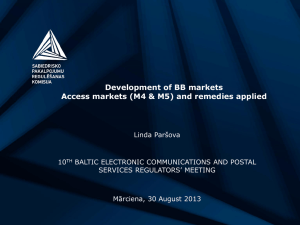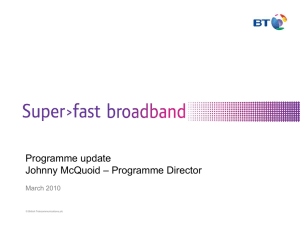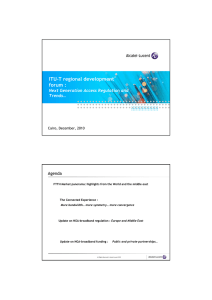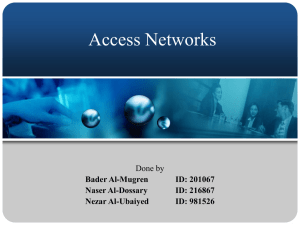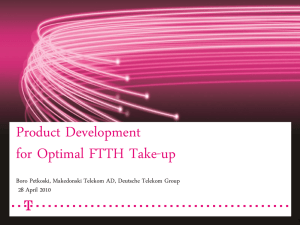Comreg
advertisement
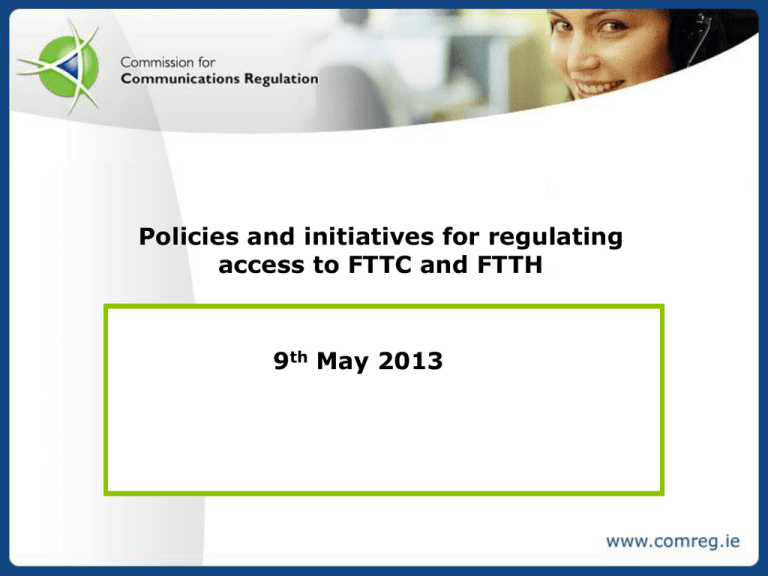
Policies and initiatives for regulating access to FTTC and FTTH 9th May 2013 2 Fibre roll out in Ireland Eircom is rolling out FTTC to approx one million premises: delivered over five phases; investing €400m in fibre infrastructure across the Republic’s 26 counties. Deployment of FTTC architecture + vectoring to deliver speeds of 70 – 100 Mbs but negligible FTTH envisaged. UPC has upgraded its fibre power network to DOCSIS 3.0: over 600,000 households capable of achieving 100 Mbs and over 725,000 attaining 30 Mbs access. ESB announced its intentions to roll out FTTH to urban and semi-urban areas and is seeking a JV partner. 3 The challenges for regulation in Ireland To drive investment and yet maintain competition; Achieved through improved conditions of wholesale access and market lead/flexible pricing structure and consistent pricing along value chain. Possible due to dynamic retail competition and by supporting alternative investment on all platforms Considered European Digital Agenda targets and National Broadband Plan – ensure market lead investment with minimal state intervention. Minimise regulatory barriers to investment therefore support the business case for investment by all market players. Acknowledge reality that in the Irish market, the business case for FTTC is stronger than for FTTH, at this point in time. Ensure Access remedies are sufficiently flexible to allow the market to move to an FTTH solution over time. 4 ComReg’s approach 1. Technology neutral approach - safeguard for competition, regardless of underlying technology 2. Mandated fibre access and virtual unbundled access 3. Supports continued investment in LLU and SLU 4. Recognise competitive dynamic in the retail market Allowing a flexible pricing structure 5. Paramount to create a level playing field: Ensuring equivalence of access through Equivalence of Input (EOI) for next generation Consistency of pricing across the value chain 6. Incentivise improved equivalence with potential to relaxing controls of the test in line with increasing competition. 5 Checking technical and economic replicability of retail products? Use of margin squeeze obligation, between retail and wholesale products and services; and between various forms of wholesale products and services. Specify appropriate margin squeeze models to ensure that operators investing in networks but who rely on key input prices are not discriminated against when compared to those investing and may get a preferential wholesale input price. Ensure appropriate economic space is maintained along value chain of regulated access products. Ensure equivalence of access (EoI) Objective is efficient infrastructure investment and promotion of effective competition, at the retail and wholesale levels 6 Managing access to SLU with Vectoring Vectoring deemed necessary for platform to compete with speeds available on cable First generation vectoring not compatible with SLU; implication is continued dominance of sub-loop Alternative demand may emerge ComReg approach SLU to be available on reasonable request Criteria Unreasonable if: FTTC/Vectoring roll out has taken place or is credibly imminent No commitment to wholesale access (VUA/Bitstream) SLU will be available where NGA clearly not viable 7 European Policy aims to drive Digital Agenda Draft Recommendation: “Consistent non-discrimination obligations and costing methodologies”. Pricing flexibility should support investment where there is a safeguard to competition Margin Squeeze test and economic replicability (would apply to any future fibre unbundling) Strong retail competition Equivalence of Inputs Predictable/stable copper prices in a band of €8-10 for LLU provides anchor price Particularly relevant where there is virtual unbundling and until a fibrebased anchor is in market Ensure consistent pricing for ladder of investment to safeguard competition. Supports pricing agreements which foster NGA



